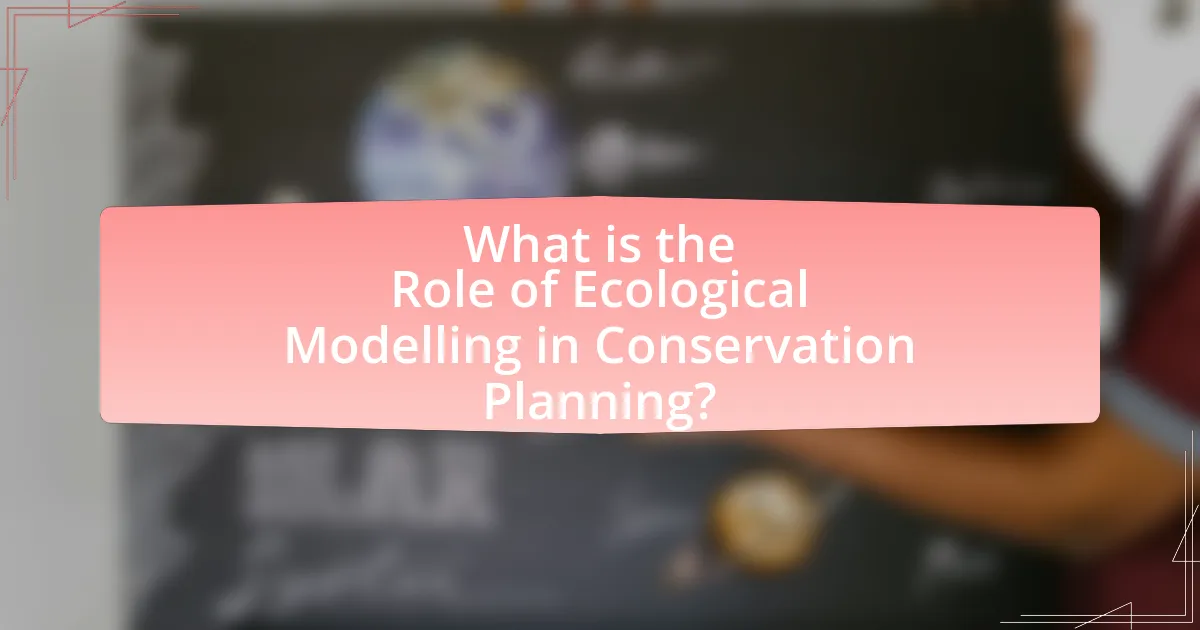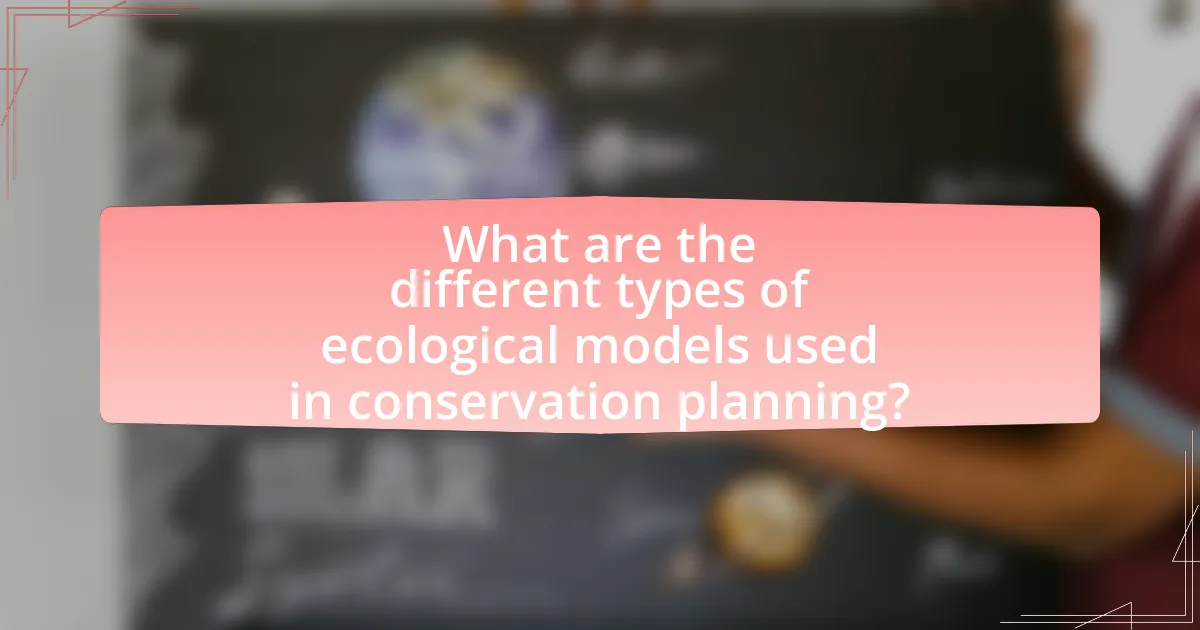Ecological modelling is a vital tool in conservation planning, providing frameworks to understand complex ecological systems and predict the outcomes of various management strategies. The article explores how these models simulate species interactions, habitat dynamics, and environmental factors, thereby enhancing decision-making processes in conservation efforts. Key principles of ecological modelling, including data integration and uncertainty assessment, are discussed alongside its applications in habitat restoration, invasive species management, and biodiversity conservation. Additionally, the article addresses the limitations and challenges faced in ecological modelling, emphasizing best practices for effective stakeholder engagement and data quality assurance.

What is the Role of Ecological Modelling in Conservation Planning?
Ecological modelling plays a crucial role in conservation planning by providing a framework for understanding complex ecological systems and predicting the impacts of various conservation strategies. These models simulate interactions among species, their habitats, and environmental factors, enabling conservationists to assess potential outcomes of different management actions. For instance, studies have shown that models can predict species responses to habitat changes, helping prioritize areas for protection or restoration. By integrating data on biodiversity, ecosystem services, and human activities, ecological modelling supports informed decision-making, ultimately enhancing the effectiveness of conservation efforts.
How does ecological modelling contribute to effective conservation strategies?
Ecological modelling contributes to effective conservation strategies by providing a framework for predicting ecosystem responses to various management actions. These models simulate interactions within ecosystems, allowing conservationists to assess the potential impacts of different strategies on biodiversity and ecosystem health. For instance, studies have shown that models can forecast species population dynamics and habitat changes, enabling targeted interventions that enhance conservation outcomes. Research published in “Ecological Applications” by McCarthy et al. (2013) demonstrates that using ecological models can improve decision-making processes by integrating scientific data with stakeholder values, ultimately leading to more effective conservation planning.
What are the key principles of ecological modelling in this context?
The key principles of ecological modelling in the context of conservation planning include the representation of ecological systems, the integration of data and theory, and the assessment of uncertainty. Ecological models aim to simulate the interactions within ecosystems, allowing for predictions about species behavior and habitat dynamics. By incorporating empirical data and theoretical frameworks, these models provide a structured approach to understanding complex ecological relationships. Furthermore, assessing uncertainty is crucial, as it helps in evaluating the reliability of model predictions and informs decision-making processes in conservation efforts.
How does ecological modelling enhance decision-making in conservation?
Ecological modelling enhances decision-making in conservation by providing data-driven simulations that predict the outcomes of various management strategies. These models integrate ecological data, allowing conservationists to assess the potential impacts of interventions on species populations and ecosystems. For instance, a study published in “Ecological Applications” by McCarthy et al. (2010) demonstrated how models can forecast the effects of habitat restoration on endangered species, enabling targeted actions that maximize conservation effectiveness. By visualizing complex ecological interactions, these models facilitate informed choices, ultimately leading to more successful conservation outcomes.
Why is ecological modelling important for biodiversity conservation?
Ecological modelling is crucial for biodiversity conservation because it enables scientists and conservationists to simulate and predict the impacts of environmental changes on ecosystems. These models help in understanding species interactions, habitat requirements, and the effects of climate change, allowing for informed decision-making in conservation strategies. For instance, a study published in “Ecological Applications” by McDonald et al. (2019) demonstrated that ecological models can effectively predict species distribution changes under various climate scenarios, thereby guiding conservation efforts to prioritize areas for protection. This predictive capability is essential for developing adaptive management plans that can mitigate biodiversity loss.
What specific challenges in biodiversity can ecological modelling address?
Ecological modelling can address specific challenges in biodiversity such as habitat loss, species extinction, and the impacts of climate change. These models simulate ecological processes and predict the effects of various factors on biodiversity, enabling conservationists to identify critical areas for protection and restoration. For instance, studies have shown that ecological models can forecast species distribution changes due to climate shifts, allowing for proactive management strategies. Additionally, models can assess the effectiveness of conservation interventions, providing data-driven insights that enhance decision-making in biodiversity conservation efforts.
How does ecological modelling help in predicting species responses to environmental changes?
Ecological modelling aids in predicting species responses to environmental changes by simulating complex interactions within ecosystems and assessing how these interactions are influenced by various environmental factors. These models incorporate data on species distribution, habitat requirements, and climate variables, allowing researchers to forecast potential shifts in species populations and distributions under different scenarios. For instance, studies have shown that models like the Species Distribution Models (SDMs) can accurately predict how climate change impacts species ranges, as evidenced by research published in “Global Change Biology” by Elith and Leathwick, which demonstrated the effectiveness of SDMs in forecasting species responses to climate variables.

What are the different types of ecological models used in conservation planning?
The different types of ecological models used in conservation planning include empirical models, process-based models, and spatial models. Empirical models rely on observed data to identify relationships between variables, making them useful for predicting outcomes based on historical data. Process-based models simulate ecological processes and interactions, allowing for a deeper understanding of ecosystem dynamics and responses to changes. Spatial models incorporate geographic information to analyze patterns and distributions of species and habitats, aiding in the identification of critical areas for conservation. These models are essential for informed decision-making in conservation efforts, as they provide insights into ecosystem behavior and potential impacts of management strategies.
What are the main categories of ecological models?
The main categories of ecological models are empirical models, theoretical models, and simulation models. Empirical models are based on observed data and statistical relationships, allowing for predictions based on historical patterns. Theoretical models focus on the underlying biological and ecological principles, often using mathematical equations to describe relationships within ecosystems. Simulation models, such as agent-based models and system dynamics models, replicate ecological processes over time to explore complex interactions and predict future scenarios. These categories are essential for understanding ecological dynamics and informing conservation planning strategies.
How do empirical models differ from theoretical models?
Empirical models differ from theoretical models primarily in their basis of development; empirical models are grounded in observed data, while theoretical models are based on abstract principles and assumptions. Empirical models utilize real-world measurements and statistical analyses to predict outcomes, making them data-driven and often more reliable in practical applications. In contrast, theoretical models rely on established theories and hypotheses, which may not always account for the complexities of real-world scenarios. For instance, in ecological modeling, empirical models can provide insights into species population dynamics based on field data, whereas theoretical models might predict behaviors based on generalized ecological principles. This distinction is crucial in conservation planning, as empirical models can offer actionable insights that are directly applicable to specific ecological contexts.
What role do spatial models play in conservation planning?
Spatial models are essential tools in conservation planning as they facilitate the analysis and visualization of ecological data to inform decision-making. These models help identify critical habitats, assess biodiversity patterns, and predict the impacts of environmental changes on species and ecosystems. For instance, spatial models can integrate various data sources, such as land use, species distribution, and climate variables, to create comprehensive maps that guide conservation priorities. Research has shown that using spatial models can enhance the effectiveness of conservation strategies by allowing for targeted interventions, optimizing resource allocation, and improving stakeholder engagement in the planning process.
How do models integrate ecological data for conservation purposes?
Models integrate ecological data for conservation purposes by utilizing algorithms and simulations to analyze species distributions, habitat conditions, and ecosystem dynamics. These models synthesize data from various sources, such as remote sensing, field surveys, and historical records, to predict the impacts of environmental changes and human activities on biodiversity. For instance, species distribution models (SDMs) use ecological niche theory to forecast how species might respond to climate change, enabling targeted conservation efforts. Research has shown that integrating ecological data through these models can enhance decision-making processes, as evidenced by studies like “The role of ecological models in conservation planning” published in the journal Conservation Biology, which highlights successful case studies where model predictions informed habitat protection strategies.
What types of data are essential for building effective ecological models?
Essential data types for building effective ecological models include species distribution data, environmental variables, and demographic information. Species distribution data provides insights into the spatial patterns of organisms, while environmental variables such as temperature, precipitation, and land use influence habitat suitability. Demographic information, including birth and death rates, helps in understanding population dynamics. These data types are crucial as they enable the modeling of interactions within ecosystems and predict responses to environmental changes, thereby supporting conservation planning efforts.
How is data quality ensured in ecological modelling?
Data quality in ecological modelling is ensured through rigorous data validation, standardization, and continuous monitoring. Researchers implement protocols for data collection that include predefined methodologies to minimize errors and biases, such as using calibrated instruments and standardized sampling techniques. Additionally, data undergoes validation processes where it is cross-checked against established datasets or expert assessments to confirm accuracy. For instance, the use of remote sensing data is often validated with ground-truthing methods to ensure reliability. Furthermore, ongoing data quality assessments are conducted to identify and rectify inconsistencies, thereby maintaining the integrity of the ecological models used in conservation planning.

What are the practical applications of ecological modelling in conservation planning?
Ecological modelling has several practical applications in conservation planning, including habitat suitability assessment, population viability analysis, and ecosystem service evaluation. Habitat suitability models help identify areas that can support specific species, guiding land-use decisions and conservation priorities. Population viability analysis uses models to predict the long-term survival of species under various scenarios, informing management strategies to prevent extinction. Additionally, ecosystem service models quantify the benefits provided by natural systems, aiding in the valuation of conservation efforts and promoting sustainable practices. These applications are supported by empirical studies, such as those published in the journal “Ecological Applications,” which demonstrate the effectiveness of modelling in enhancing conservation outcomes.
How can ecological modelling inform habitat restoration efforts?
Ecological modelling can inform habitat restoration efforts by providing data-driven insights into ecosystem dynamics and species interactions. These models simulate various scenarios, allowing conservationists to predict the outcomes of different restoration strategies. For instance, a study by McDonald et al. (2016) demonstrated that using ecological models helped identify optimal planting strategies for restoring degraded wetlands, resulting in a 30% increase in biodiversity compared to traditional methods. By integrating factors such as climate change, soil conditions, and species requirements, ecological modelling enhances decision-making processes, ensuring that restoration efforts are both effective and sustainable.
What case studies demonstrate successful applications of ecological modelling?
Case studies demonstrating successful applications of ecological modelling include the use of the Integrated Valuation of Ecosystem Services and Tradeoffs (InVEST) model in the Pacific Northwest, which assessed the impacts of land-use changes on ecosystem services. This model provided critical insights that informed land management decisions, leading to enhanced conservation strategies. Another example is the use of the Ecopath with Ecosim (EwE) model in the Gulf of California, which helped in understanding fishery dynamics and ecosystem interactions, ultimately guiding sustainable fishing practices. These case studies illustrate how ecological modelling can effectively inform conservation planning and resource management.
How does ecological modelling assist in managing invasive species?
Ecological modelling assists in managing invasive species by providing predictive frameworks that simulate the potential spread and impact of these species within ecosystems. These models analyze various factors such as environmental conditions, species interactions, and human activities to forecast invasion scenarios. For instance, studies have shown that models like the MaxEnt (Maximum Entropy) can predict the distribution of invasive species based on environmental variables, allowing for targeted management strategies. Additionally, ecological models can evaluate the effectiveness of different control measures, helping conservationists prioritize resources and interventions based on predicted outcomes. This data-driven approach enhances decision-making and improves the efficiency of invasive species management efforts.
What are the limitations and challenges of ecological modelling in conservation?
Ecological modelling in conservation faces several limitations and challenges, primarily related to data availability, model complexity, and uncertainty. Data scarcity often hinders the development of accurate models, as many ecological systems lack comprehensive datasets. For instance, a study by McCarthy et al. (2013) highlights that insufficient data can lead to unreliable predictions, impacting conservation decisions. Additionally, the complexity of ecological interactions makes it difficult to create models that accurately represent real-world scenarios, as noted by Levin (1992), who emphasizes that oversimplification can result in loss of critical ecological dynamics. Furthermore, uncertainty in model parameters and environmental variability complicates the interpretation of model outputs, as indicated by the work of McGowan et al. (2017), which shows that high uncertainty can undermine stakeholder confidence in model-based recommendations. These factors collectively challenge the effectiveness of ecological modelling in informing conservation strategies.
What uncertainties are associated with ecological models?
Ecological models are associated with uncertainties primarily due to limitations in data quality, parameter estimation, and model structure. These uncertainties arise because ecological systems are complex and often exhibit nonlinear interactions that are difficult to capture accurately. For instance, data scarcity can lead to reliance on assumptions that may not hold true in real-world scenarios, resulting in predictions that deviate from observed outcomes. Additionally, parameter estimation can be influenced by measurement errors or variability in ecological processes, further compounding uncertainty. A study by McCarthy et al. (2010) highlights that model structure itself can introduce uncertainty, as different modeling approaches may yield varying results even when applied to the same dataset. Thus, the interplay of data limitations, parameter estimation challenges, and model structural choices contributes significantly to the uncertainties inherent in ecological models.
How can these limitations be addressed in conservation planning?
Limitations in conservation planning can be addressed by integrating ecological modeling to enhance decision-making processes. Ecological modeling provides a framework for simulating various scenarios, allowing planners to assess the potential impacts of different conservation strategies on biodiversity and ecosystem services. For instance, models can predict species responses to habitat changes, enabling targeted interventions that are more likely to succeed. Research by Ferrier et al. (2000) in “Biodiversity Conservation” demonstrates that incorporating spatially explicit models improves the identification of priority areas for conservation, thereby optimizing resource allocation. By utilizing these models, conservation planners can make informed decisions that effectively mitigate limitations such as data gaps and uncertainty in ecological responses.
What best practices should be followed when using ecological modelling in conservation planning?
Best practices for using ecological modelling in conservation planning include ensuring data quality, involving stakeholders, and validating models. High-quality data is essential for accurate predictions; for instance, using comprehensive datasets improves model reliability. Engaging stakeholders, such as local communities and conservationists, fosters collaboration and ensures that models address relevant ecological and social factors. Model validation, through comparison with empirical data, enhances credibility and informs adaptive management strategies, as demonstrated in studies like the one by McCarthy et al. (2010) in “Ecological Modelling.” These practices collectively enhance the effectiveness of ecological modelling in achieving conservation goals.
How can stakeholders be effectively engaged in the modelling process?
Stakeholders can be effectively engaged in the modelling process by incorporating them early in the development stages and ensuring their input shapes the model’s objectives and parameters. This engagement fosters ownership and enhances the relevance of the model to real-world scenarios. Research indicates that participatory approaches, such as workshops and collaborative meetings, significantly improve stakeholder involvement and satisfaction, as evidenced by a study published in “Ecological Modelling” by Reed et al. (2013), which highlights the importance of stakeholder feedback in refining ecological models.
What tools and resources are available for practitioners in ecological modelling?
Practitioners in ecological modelling have access to various tools and resources, including software platforms like R, Python, and MATLAB, which facilitate data analysis and model development. Additionally, specialized ecological modelling software such as Ecopath with Ecosim, Vensim, and Stella provide frameworks for ecosystem modeling. Online resources, including the Ecological Society of America and the Society for Conservation Biology, offer guidelines, case studies, and forums for collaboration. Furthermore, academic journals like “Ecological Modelling” publish research that can inform practitioners about the latest methodologies and applications in the field. These tools and resources collectively enhance the capacity of practitioners to conduct effective ecological modelling for conservation planning.


